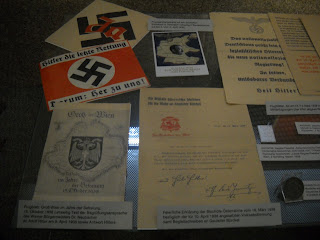Wien is a city rich in culture but also full of military conquests and defeats. The wars with the Ottomans, France, Prussia and allied powers during WWI and WWII have left lasting effects on Wien's history and its people; not to mention the occupation of Austria and Wien by Nazi Germany as well as Russia.

Today I learned about the history of the Viennese at the Heeresgeschichtliches Museum (Museum of Military History), the first museum to be built within the city boundaries. It is located right off of the Ringstraße in the Wien Arsenel, which was built between 1848-1856 and replaced the old city fortification. The museum was finished in 1891 and was used as barracks and armory during WWI. The museum itself is quite beautiful to walk into. The room you enter into today is known as "The Hall of Strategists" and has high vaulted ceilings with marble statues. Unfortunately this is the only museum that I have been too in Wien where I have to pay a fee to take pictures. I feel like this is rather ridiculous, although one sticker (that shows you've paid the three euro) will suffice for the entire group. Good thing Jordan is rich and didn't mind fronting the money!

The point of this visit was to focus on the Ottoman Empire and the portrayal of Turks and Christians during the Thirty Years War, although I did tour the entire museum. Class lecture and handouts from the Heeresgeschichtliches Museum revealed that European history in the 17th century was torn between the conflicts of Christianity vs. Protestantism and the Ottoman threat upon Wien and the Habsburg Empire from the East. The Thirty-Years War was initially fought as a war against Christianity and Protestantism, although it was as much about the Bourbon and Habsburg rivalry for power politics in Europe. The Turks became involved in the war when the Protestant Hungarian Prince of Transylvania, Bethlen Gabor, requested aid against the Habsburgs through Ottoman Sultan Osman II. The Ottomans gave 60,000 cavalry to Frederick V and said they would invade Poland with 400,000 troops if an annual tribute was paid to the Sultan. This set off the Polish–Ottoman War of 1620-21 where the Ottomans defeated the Poles who were supporting the Habsburgs in the Thirty Years' War. I wont go into the logistics of the fighting in this blog, but it was the Thirty Years War that marked the last religious war between Protestants and Catholics in Europe as well as the end of the Reformation. It was after the mess that Prince Eugene of Savoy became known as the defeater of the Turks during the second seize of Wien in 1683.
There is a lot of great artwork in the Heeresgeschichtliches Museum that portrays the differences between Turks and Christians. The museum is biased because its represents the military history of the Viennese in Wien. I am sure if I walked around in a Turkish museum than the portraits and art would be heavily in their favor. The Turks are shown as a noticeably foreign and menacing group. They are evil and corrupt in that they want to destroy the Holy Roman Empire. In comparison the Christians are seen as white, noble and virtuous. They are the saviors of the empire and it's last defense against the barbarians. History is always portrayed in a positive light for the victors, and in the case of the Christians in the artifacts at the Heeresgeschichtliches Museum that is no exception. Below is a sculpture of Albrecht Wenzel Eusebius von Wallenstein, the supreme commander of the armies of the Habsburg Monarchy and one of the major figures of the Thirty Years' War. Below him is a portrait of a Turkish man. Notice a difference?


There were some other really interesting artifacts that I enjoyed seeing while at the museum. The uniform and car that Archduke Francis Ferdinand was on display, as well as pictures of the Serbian nationalists who conspired in his murder. His death is what made the Austria-Hungarian Empire declare war on Serbia and form the split in politics that led to the outbreak of WWI.


There was also a great deal of Nazi regalia, which I found interesting because I had never seen it up close. After talking with students I found that most found this to be the "more interesting" part of the tour because they felt it was something that directly affected people in their families (i.e.: grandparents, great grandparents). I don't feel this way because it was Wien's past history that led to its involvement with the Nazi's and occupation during The Great War. You have to look at the past to understand the future.


There was a great deal of interpretive art within the exhibit that dealt with the horrendous actions of the Nazi's throughout Austria and the rest of Europe. I think this added an element of emotion to the museum that would not have been felt otherwise. Themes of cannibalism, castration and death were repeatedly used in this exhibit.


More to come soon...

No comments:
Post a Comment